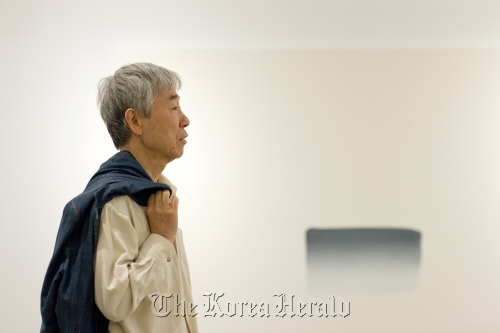Korean artist holds first solo show at Gallery Hyundai after monumental Guggenheim retrospective in New York
Only ten canvases are displayed on the first and second floors of Gallery Hyundai in Sagan-dong, central Seoul, creating a tranquil and somewhat vacant atmosphere. As if adding to the mood, each canvas features only a single square-shaped dot in the signature form of artist Lee Ufan.
He made it a point, said the South Korean artist, to put as little as possible in the gallery to maximize the margins.
“In terms of oriental paintings, blank space is where nothing is drawn. But my definition of blank space is different. It is the vibration between drawn parts and undrawn parts. So it is more like a ‘state of blankness,’ like how a bell vibrates when tolled. I deliberately selected paintings with only one dot for this show,” Lee told the press.
It is the first solo exhibition Lee has held in Seoul since the monumental retrospective show “Marking Infinity” he held at the Solomon R. Guggenheim Museum in New York this year. Lee not only successfully introduced his name to New Yorkers ― about 4,000 visited the exhibition per day ― but also confirmed his status here as one of the nation’s representative artists, judging from the unusually large number of press gathered for a single artist on Monday.
“It (the Guggenheim exhibition) was nice. They responded to my work with no idea where I was from, and only found out later that I am Korean. When an Asian artist holds a show, many easily remark that the works are oriental or Korean or Japanese. Even artists say so themselves. But those are actually very negative words, meaning that they won’t even evaluate it.
 |
Lee Ufan with his work “Dialogue” on Monday at Gallery Hyundai in Sagan-dong, central Seoul. (Gallery Hyundai) |
“An artist should be considered to be pondering what the rest of the world is discussing at the moment as well. If one says that it is very ‘Korean,’ it is isolating it, saying that ‘it has nothing to do with us, so you can do whatever you want to do,’” said Lee.
Among many reviews from the foreign press, several pointed out that Lee expanded the horizon of post-minimalism artists. It was ironic, however, because Lee has always been against minimalism and even, modern art as a whole.
“About 90 percent of the viewers see my work like that. I understand them in a way, because I do push my works to extreme simplicity. But while minimalism is to prove the work is “just (as) it is,” meaning that it is none other than the work itself, what I want to show through my work is that it is ‘something other than it is.’ I minimize the work to better show its surroundings. But I don’t fight with the critics, I am just relieved that they call me ‘post’ minimalist at least,” said Lee, chuckling.
Lee is, in fact, a key theorist of Mono-ha, an antiformalist movement which started out in Japan in the 1960s. As an artist, he presents thought-provoking installations featuring rocks and steel, and paintings consisting of simple dots or lines.
“I am opposed to defining ‘expression’ as a show of one’s inner side. Rather, I think it is connecting me with the outside and producing something when the two collide. I work to produce that stage of collision and relation. This exhibition, ‘Dialogue,’ is also in line with the context. I want to make things face each other and have a dialogue,” he said.
Because Lee’s paintings look so simple, many often say, jokingly, that even they could do it. Lee was okay with the joke but added that it is actually a result of seriously hard labor even for a skilled artist, and that it sometimes takes up to 40 to 50 days to paint a single dot.
“It is important to give a feeling that it can be done by anyone. One may imitate it, but cannot do the same. One needs great power to do it, otherwise, the vibration will not be created. Provoking correspondence between its surroundings, of course, is also important. That is what I have been struggling to achieve for so many years.
“Getting older, though, I am not so sure how long I can do it. I am making less work every year and there is a possibility that the size of the paintings will get smaller,” said the 75-year-old artist.
The exhibition runs through Dec. 18 at Gallery Hyundai in Sagan-dong, central Seoul. For more information, call (02) 734-6111~3 or visit www.galleryhyundai.com.
By Park Min-young (
claire@heraldcorp.com)




![[Herald Interview] 'Trump will use tariffs as first line of defense for American manufacturing'](http://res.heraldm.com/phpwas/restmb_idxmake.php?idx=644&simg=/content/image/2024/11/26/20241126050017_0.jpg)

![[Health and care] Getting cancer young: Why cancer isn’t just an older person’s battle](http://res.heraldm.com/phpwas/restmb_idxmake.php?idx=644&simg=/content/image/2024/11/26/20241126050043_0.jpg)

